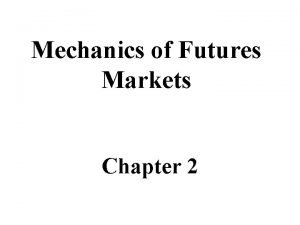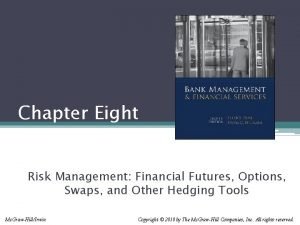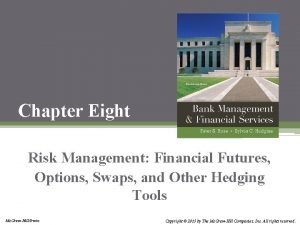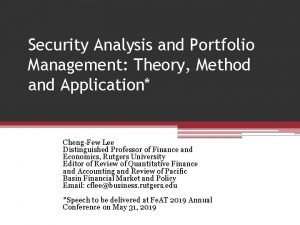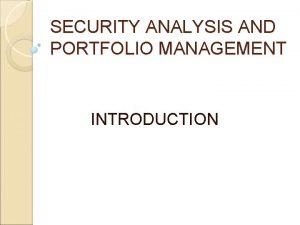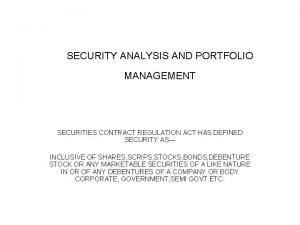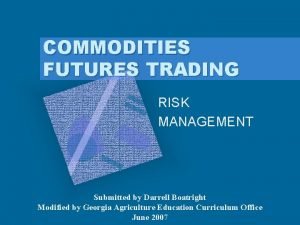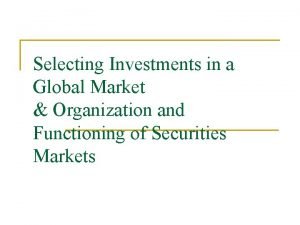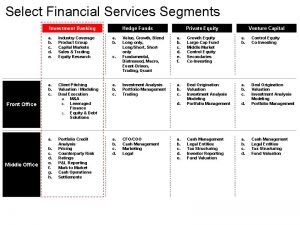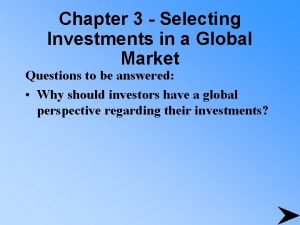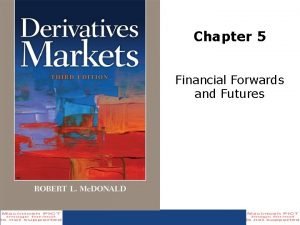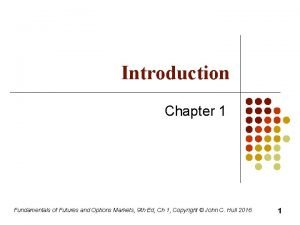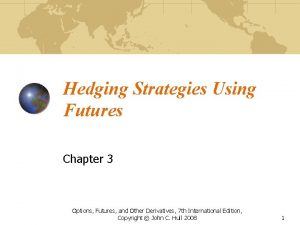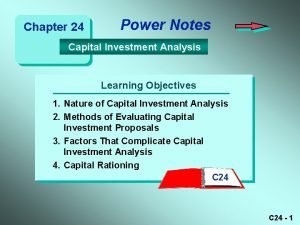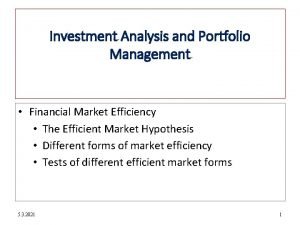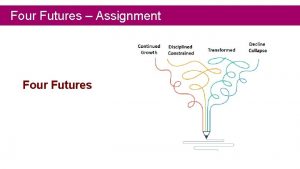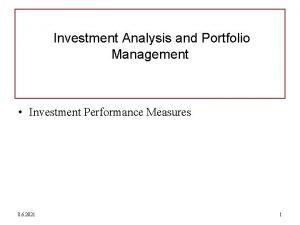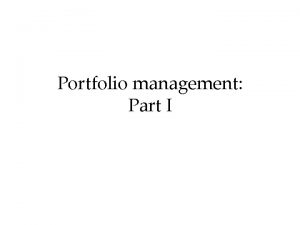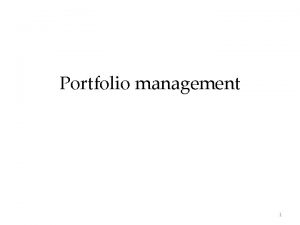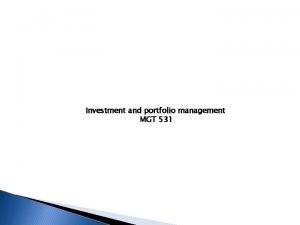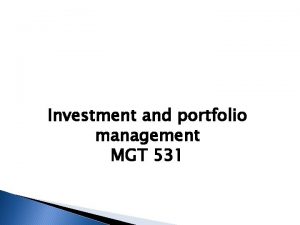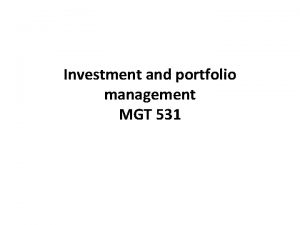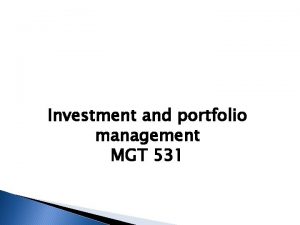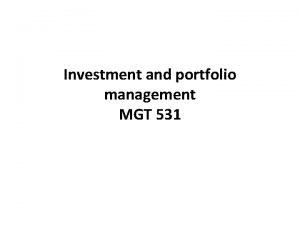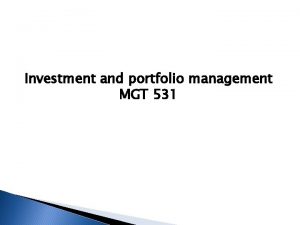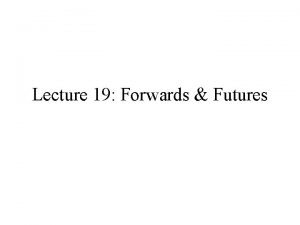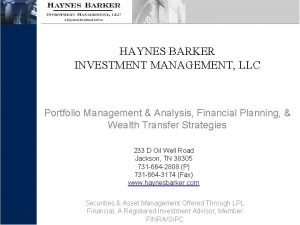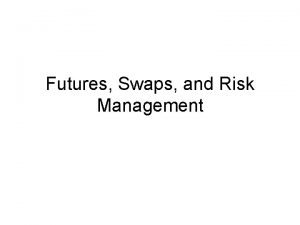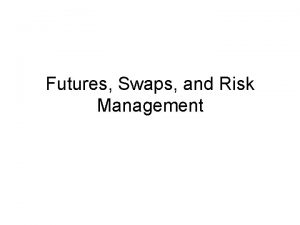Investment Analysis and Portfolio Management Futures Market and





























- Slides: 29

Investment Analysis and Portfolio Management Futures Market and Risk Management Attila Odabasi Main Points: • Motivation • Forward Contracts • Future Contracts • Valuation of Forwards and Futures • Applications 1

Futures and Forwards • Forward - an agreement calling for a future delivery of an asset at an agreed-upon price • Futures - similar to forward but has standardized terms and is traded on an exchange. • Key difference in futures – Futures have secondary trading (liquidity) – Marked to market – Standardized contract terms such as delivery dates, price units, contract size – Clearinghouse guarantees performance

Types of Contracts • Agricultural commodities • Metals and minerals (including energy contracts) • Financial futures – Interest rate futures – Stock index futures – Foreign currencies

Trading With and Without a Clearinghouse The clearinghouse eliminates counterparty default risk; this allows anonymous trading since no credit evaluation is needed. Without this feature you would not have liquid markets.

Mechanics- The Clearinghouse and Open Interest • Clearinghouse - acts as a party to all buyers and sellers. – Seller of the contract for the long position – Buyer of the contract for the short position • A futures participant is obligated to make or take delivery at contract maturity • Closing out positions – Take or make delivery – Reversing the trade – Most trades are reversed and do not involve actual delivery • Open Interest – The number of contracts opened that have not been offset with a reversing trade: measure of future liquidity

Key Terms for Futures Contracts • The Futures price: agreed-upon price paid at maturity • Long position: Agrees to purchase the underlying asset at the stated futures price at contract maturity • Short position: Agrees to deliver the underlying asset at the stated futures price at contract maturity • Profits on long and short positions at maturity – Long = ST – F 0 – Short = F 0 - ST – F = Futures price, S = spot price – At contract maturity T: FT= ST

Ex: Future Contract on oil • NYMEX crude oil (light) futures with delivery in Dec. 2007 at a price of $75. 06/b on July 27, 2007 with 51, 475 contracts traded • Each contract is for 1, 000 barrels • Tick size: $0. 01 per barrel, $10 per contract • Initial margin: $4050 • Maintenance margin: $3, 000 • No cash changes hands today (contract price is $0) 71

Ex: Future Contract on oil • NYMEX crude oil (light) futures with delivery in Dec. 2007 at a price of $75. 06/b on July 27, 2007 • Each contract is for 1, 000 barrels • F 0 on July 27 = 75. 06$/b • Contract value= 75, 060 $ • ST on July 27 = 77$/b • Long-position Profit= (77 – 75. 06)x 1000= 1940$ • Short-position Loss= (75. 06 – 77)x 1000= -1940$ 81

Payoff Diagram, Dec 2007 Contract Long position (buy) $ Profit Short position (sell) Long Position ST – F 0 ST F 0 Oil price, Dec 2007 Short Position F 0 - ST 9

Marking to Market and the Margin Account • Each trader opens a margin account. Initial Margin: funds that must be deposited in a margin account to provide capital to absorb losses. – Initial margin set to 5 -15% of the contract value. • On any day, future prices may rise or fall. Profits and losses are recognized as they accrue daily and reflected in the margin accounts (Marking to Market). – Pay- (or receive-) as-you-go method • Maintenance margin: an established value below which a trader’s margin may not fall. – Margin call occurs when the maintenance margin is reached, broker will ask for additional margin funds…

Marking to Market, Buyer’s account • Contract: 5000 bushels of wheat at 4$ per bushel. Contract value is: 5000 x$4=$20, 000. Buyer deposits an initial margin of 5% of the transaction value (that is $1, 000). Day Settle Price $ Value Chng Buyer’s equity Margin Account Total % HPR (cum) SPOT HPR (cum) 0 $4 $20, 000 1 $4. 10 $20, 500 $ 500 1500 50% 2. 5% 2 $3. 95 $19, 750 $-750 -25% -1. 25% $1000 Maintenance margin: percentage of initial margin. 11

Marking to Market, Seller’s account • Contract: 5000 bushels of wheat at 4$ per bushel. Contract value is: 5000 x$4=$20, 000. Seller deposits an initial margin of 5% of the transaction value (that is $1, 000). Day Settle Price $ Value Chng Seller’s equity Margin Account Total % HPR (cum) SPOT HPR (cum) 0 $4 $20, 000 1 $4. 10 $20, 500 $ -500 -50% -2. 5% 2 $3. 95 $19, 750 $ 750 1250 25% 1. 25% $1000 Leverage multiplier = 20, contract value of $20, 000 versus initial margin of $1000 12

More on futures contracts • Convergence of Price: As maturity approaches the spot and futures price converge. A commodity available from two sources (spot vs futures markets) must be priced identically. • What happens at maturity: • Delivery of actual commodity: Specifications of when and where delivery takes place and what can be delivered written in the contract • Cash Settlement: Delivery of a cash amount equal to the value of the underlying asset at maturity (ex: Index contracts)

What Determines Forward or Futures Prices? • Forward/futures prices ultimately linked to future spot prices • Notation: Contract Price Spot at t St Futures Ft, T • Two ways to buy the underlying asset for date-T delivery: 1. Buy a futures contract with maturity date T 2. Buy the underlying asset now and store it until T 141

Valuation of Futures • • Gold: Easy to store (negligible costs of storage) No dividends or benefits Two ways to buy gold for T – Buy now for S 0 and hold it until T – Buy future at 0, pay F 0, T at T and take delivery at T – No arbitrage requires that: • F 0, T = S 0 (1+r)T 15

Valuation of Futures, example w/ Gold Date A: Future Contract B: Outright Asset Purchase Cash flow at 0 • Enter long posittion: $0 Invest: -F 0, T/(1+r)T • Buy gold: -S 0 • Cash flow at T • Long position: ST - F 0, T • Investment: +F 0, T Total at T • • ST Gold value: ST ST Since both strategies end up with the same CF at T, their initial costs should be the same: F 0, T = S 0(1+r)T Otherwise arbitrage profites would be earned. 16

Example • Suppose gold currently sells for $1200 an ounce. If the risk-free rate is 0. 1% per month, a six-month maturity futures contract should sell for: • F 0 = S 0(1+r)6/12 = 1200 (1. 012)1/2 = $1207. 18 • If the equation does not hold, arbitrage opportunity possible. • Suppose, F 0 is $1210 instead of $1207. 18, we can realize profits by pursuing the strategy: … 17

Arbitrage Ex: Gold Action Borrow $1, 200, repay with interest at T Buy gold at $1, 200 t=0 T (six months) $1, 200 -1, 200(1. 012)^0. 5 -$1, 200 $ST Enter short position (F 0=1, 210) $0 1, 210 - ST Total $0 $2. 82 Net initial investment is $0. Cash flow at T is positive and riskless. The profit is equal to mispricing of the futures contract. Risk is eliminated because profits and losses on the futures and gold positions exactly offset each other. 18

Valuation of Futures • Financials: • Let underlying be a financial asset – No cost to store the underlying asset – Dividend or interest on the underlying • Example: Stock Index futures – Underlying are bundles of stocks, S&P 500, BIST 30 – Futures settled in cash (No delivery) – Let the annualized dividend yield be d; then • F 0, T = S 0 (1+r-d)T 19

Stock Index Futures 20

BIST-30 Contract Features Dayanak Varlık Underlying Asset Sözleşme Büyüklüğü Contract Size BIST-30 index value (Ulusal hisse senedi fiyat endeksinin hesaplama yöntemi kullanılarak bu endekse dahil olan şirketlerin hisse senedi fiyatlarından elde edilen değer. ) (BIST-30 Index /1000)*100 TL [Ex: (91, 000/1000)*100 = 9, 100 TL] Kotasyon Şekli Quotation BIST-30 Index divided by 1000. Three digits in decimals. [Ex: 91000 / 1000 = 91. 000]. Günlük Fiyat Hareket Sınırı Daily Price Range % +15 of Base Price Minimum Fiyat Adımı Tick Size 0. 025 (or 25 index points) Ex: from 91. 000 to 91. 025 Or from 91000 to 91025 Contract value= from 9100 TL to 9102. 5 TL so Tick Size= 2. 5 TL). 21

Vade Ayları Expiration Months February, April, June, August, October and December. Sözleşmenin Vadesi Contract Maturity Day Last day of the maturity month. Son İşlem Günü Last Transaction Day Last day of the maturity month Uzlaşma Şekli Settlement Type Cash Settlement 221

Trading Strategies • Speculation: to profit from movements in future prices – Go short if you believe price will fall – Go long if you believe price will rise • Hedging: to protect against price movements – Oil distributor planning to sell 100, 000 barrels of oil in March that wishes to hedge against a possible decline in oil prices. Because each contrat calls for delivery of 1, 000 barrels, it would sell 100 contracts. – Any decrease in prices would generate a profit on the contracts that would offset the lower sales revenue from the oil.

Hedging of Equity Portfolios • Suppose you have a diversified portfolio of large-cap stock worth $5 mio and are now worried about equity markets (downward risk) and would like to hedge your exposure to equity market. How could you use S&P 500 futures to implement this hedge? (assume index level is 2000) – Short sell 10 S&P 500 futures contracts (why 10? ) 24

Example (cont) • Compare hedged and unhedged portfolio (in $mio): S&P 500 Cash Portfolio (Equity bought) Cum Change Cash Plus Futures in Margin Portfolio Account 1800 $4. 5 $0. 5 $4. 5 + $0. 5 = $5* 2, 000 $5. 0 $0. 0 $5 + $0 = $5 2, 200 $5. 5 $-0. 5 $5. 5 - $0. 5 = $5 This is a 100% hedge. The outcome is constant at $5 mio. * Equity + Profit on contracts= 4, 500, 000+(10 x 200 x 250)= $5, 000 25

Hedging Systematic Risk To protect against a decline in stock prices, short the appropriate number of futures index contracts. • Use the beta for the portfolio to determine the hedge ratio. 26

Hedging Systematic Risk Example Portfolio Value = $30 million, and Portfolio Beta =. 8 S&P 500 = 1, 000 If Expected Decrease = 2. 5% => S&P falls to 975 Projected loss for the portfolio: (. 8) (-2. 5%) = -2% 30 mio x -0. 02= $600, 000 Change in S&P 500 index contract value= (975 – 1000)x 250 = $6250. Hedge Ratio= H= Change in portfolio value / profit by contract H = $600, 000 / $6250 = 96 contracts Strategy: Equity portfolio long and 96 index contracts short. 27

Application: Creating Synthetic Positions with Futures for market timing • Index futures let investors participate in broad market movements without actually buying or selling large amounts of stock. • Results: – Cheaper and more flexible – Synthetic position; instead of holding or shorting all of the actual stocks in the index, you are long or short the index futures 28

Investing on Index Futures, example • You have $1 mio to invest in the stock market and you have decided to invest in the S&P 500. How would you do this? • One way is to buy the S&P 500 in the spot market: – Buy the 500 stocks, weights proportional to the market caps • Another way is to buy S&P 500 futures: – value of a futures contract is $250 times the S&P 500 index – Assuming the S&P 500 is at 2000, one index contract is worth= $250 x 2000= $500, 000 – number of contract to buy: • $1, 000 / (500, 000) = 2 contracts • Assume 10% margin, you deposit $100, 000 and invest $900, 000 at risk-free rate. 291
 Investment analysis and portfolio management notes
Investment analysis and portfolio management notes Scope of investment analysis and portfolio management
Scope of investment analysis and portfolio management Investment analysis and portfolio management course
Investment analysis and portfolio management course Investment analysis & portfolio management
Investment analysis & portfolio management Fixed investment and inventory investment
Fixed investment and inventory investment Market segmentation market targeting and market positioning
Market segmentation market targeting and market positioning Mechanics of futures market
Mechanics of futures market Mechanics of futures market
Mechanics of futures market Mechanics of futures markets
Mechanics of futures markets Andy philpott
Andy philpott Market follower
Market follower Options futures and risk management
Options futures and risk management Traders in financial futures
Traders in financial futures Security analysis and portfolio management project
Security analysis and portfolio management project Security analysis and portfolio management project
Security analysis and portfolio management project Importance of security analysis and portfolio management
Importance of security analysis and portfolio management Risk in security analysis and portfolio management
Risk in security analysis and portfolio management Futures trading risk management
Futures trading risk management Weebly portfolio examples
Weebly portfolio examples Investment risk example
Investment risk example Bulge bracket
Bulge bracket Selecting investment in global market
Selecting investment in global market Futures and forwards
Futures and forwards Options, futures, and other derivatives
Options, futures, and other derivatives Fundamentals of futures and options markets
Fundamentals of futures and options markets Currency futures and options
Currency futures and options Tailing the hedge
Tailing the hedge Financial investment analysis
Financial investment analysis Factors that complicate capital investment analysis
Factors that complicate capital investment analysis Financial investment analysis
Financial investment analysis






